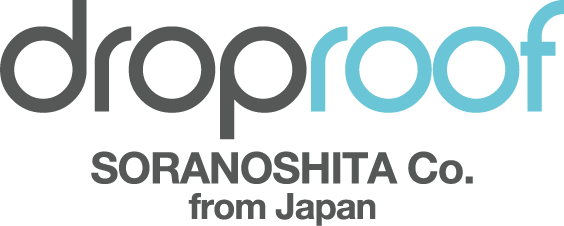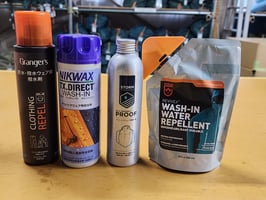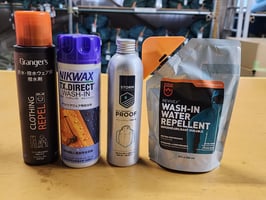To make outdoor activities comfortable, a rain jacket with a water-repellent coating that repels...
The Ultimate Guide to Water Repellents: How Great Are Nikwax Water Repellents and What to Expect When Using Them?
If you are an adventurous soul who loves to explore the great outdoors, you understand the importance of protecting your gear from the elements. This is where water repellents come into play, and products such as Nikwax, Granger's, Atsko, and Gear Aid may come to mind. This comprehensive guide delves into the world of these water repellents and provides the ultimate knowledge for mastering this technique. We also provide tips on how to use water repellents effectively.
However, even these wonderful water repellents have their limitations. Some of you may have experienced that DWR was not restored after using these products. This is a matter of methodology and the limitations of these water repellents. Since not all people will be satisfied with these products, we will also explain who these water repellents are suitable for and what to do if they are not.
Understanding Water Repellents
Water repellents are essential for outdoor enthusiasts to provide an additional layer of protection for their gear. Water repellents create a hydrophobic coating on the surface of the fabric, preventing the fabric from absorbing water and damaging the climber. Understanding the science behind water repellents is critical to making an informed decision about which product to choose.
Water repellents are usually made of hydrophobic chemicals with low surface tension. This low surface tension causes water to pool and roll off the surface rather than be absorbed. The effectiveness of a water repellent depends on how strongly it bonds to the material and remains hydrophobic over time without shedding.
Benefits of Using Water Repellents
The benefits of using a water repellent are numerous. First, they protect climbers from damage caused by water. Specifically, body cooling due to wetness, increased gear weight due to water absorption, and herding due to reduced moisture permeability. Whether it's a sudden rain shower or a river crossing, water repellents keep your belongings dry and your outdoor adventures comfortable.
Water repellents also play an important role in prolonging the life of your gear. By preventing water absorption, they reduce the risk of mold and white mold growth, which can cause odors and material deterioration. In addition, it should be noted that water repellency also allows gear to dry faster. For example, gear that has been drenched in rain will dry the next day. Since it is less likely to absorb water in the first place, it will also dry more easily.
Different Types of Water Repellents
There are many different types of water repellents, each with its own unique properties and uses. The most common would be waterproofing sprays. However, waterproofing sprays can affect the environment and the human body, so their use is decreasing.
Used instead are direct-in water repellents such as Nikwax, which can be placed in the washing machine to create a water repellent finish. These products provide water repellency in a simple process, requiring only an appropriate amount to be mixed with wet rain jacket after washing and then washed again.
Wax-based repellents, like traditional wax or beeswax, provide a natural and environmentally friendly option. These repellents offer good water repellency and can be used on a wide range of materials, including leather and canvas. However, they may require more frequent reapplication compared to other types of repellents.
Advantages of wash-in water repellents such as Nikwax
In addition to Nikwax, wash-in water repellents such as Granger's, Atsko, and Gear Aid are the most common water repellents used by mountain climbers because they are readily available and provide water repellency in a simple process at home.
Furthermore, most of these products are PFC-free, meaning that they do not contain fluorine, and thus pose minimal risk to the environment and human health.
Another great feature of Nikwax is that it restores water repellency without the need for heat. The technology to give water repellency without applying heat is not easy to achieve, and I would like to express my respect for their technological development.
On the other hand, wash-in water repellents also have their limitations. While wash-in type water repellents can easily provide water repellency, it is difficult to provide water repellency as high as the water repellency at the time of manufacture. This is because the manufacturing process is completely different from these products. Specialized equipment and technology are needed to provide high performance. It is better to leave these things to DWR experts like us.
Therefore, what I would like to suggest is that a wash-in type or a DWR process by a specialist may be suitable depending on the performance required. Since the wash-in type is only a simple water repellent treatment, it will not satisfy all climbers.
Proper use of NIKWAX
(1) Pumping spray type
To effectively prolong the life of water repellent, it is important to apply it correctly. Here is a step-by-step explanation of the correct way to apply Nikwax. 1:
- first, clean the item you wish to apply the water repellent to. Any detergent can be used to wash the item, but since this may affect the subsequent water repellent performance, use a detergent from the same manufacturer that sells the respective water repellent to remove dirt, handprints, and any residue from the previous water repellent. Rinsing three times is recommended to avoid detergent residue from affecting the next step. It is important that the item be slightly damp before proceeding to the next step. 2.
- shake the Nikwax product well to ensure that the ingredients are properly mixed. If the product has been stored for a long period of time, the ingredients may have precipitated. Shaking the product, even when it is not in use, will prevent the ingredients from precipitating out.
- apply Nikwax to the surface of the fabric by pumping spray evenly.
- allow the product to penetrate the material for a few minutes. If necessary, remove excess with a sponge or soft cloth. Wipe evenly here to avoid unevenness. Pay special attention to seams and heavily worn areas.
- hang or lay flat to dry naturally. Since Nikwax does not require heat treatment, it should be allowed to dry naturally only for a sufficient amount of time. If drying is inadequate, performance will not be achieved. 6.
- When the item is dry, check to see if there are any areas that require additional treatment. If necessary, apply two coats.
- test the water repellency by pouring a small amount of water on the surface. If the water beads up and rolls off, the water repellent treatment has been successful.
(2) Wash-in type
- First, remove dirt from the item to be treated with the water-repellent finish. First, remove dirt from the item to be treated with the water repellent finish.
- After washing in step 1, put the wash-in type detergent into the detergent slot and wash, rinse, and briefly dehydrate again. Again, be careful not to add too much water repellent, and follow the amount indicated on the package. 3.
- The garment treated in 2. is still wet, but drain off the water easily and hang it to dry. Depending on the drying area, take at least one day to dry the garment thoroughly.
- test the water repellency by pouring a small amount of water on the surface. If the water beads up and rolls off, the water repellency has been successfully applied.
Tips and Tricks to Get the Most Out of Your Nikwax Treatment: Tips and Tricks to Get the Most Out of Your Nikwax Treatment
Here are some tips and tricks to help you get the most out of your Nikwax treatment:
- Apply Nikwax to clean, slightly damp gear to ensure optimal absorption and adhesion. Dry gear may cause uneven absorption and staining.
- Clean regularly before stains become visible. In addition to superficial dirt, dirt on the underside, where it comes in contact with human skin, can degrade the performance of Gore-Tex.
- Observe the required amount. It may seem that the more water repellent you use, the higher the water repellency, but this is not true. The key is to soak the water repellent in a thin layer, as this will only lead to stains and other defects.
- Especially in the case of thick fabrics, carefully observe whether there are any villages where the water repellent can be wiped off. Areas with thicker fabrics are more likely to accumulate water repellent and form water repellent stains. Therefore, areas with thicker fabrics should be observed carefully and additional wiping should be performed.
- To maintain the water repellent effect, treated gear should be stored in a dry place. Store in a well-ventilated area, as storing in a damp place can cause mold.
- Follow the manufacturer's instructions and recommendations for the Nikwax product to be used.
Alternatives to Nikwax: Exploring Other Water Repellent Brands
While Nikwax is renowned for its quality and performance, there are other water repellent brands worth exploring. Some popular alternatives include Granger's, Atsko, and Gear Aid. Each brand offers a range of products designed for different materials and outdoor activities.
Granger's, for example, specializes in environmentally friendly water repellents that are PFC-free. Atsko focuses on creating products for extreme conditions, such as hunting and fishing gear. Gear Aid offers a wide range of water repellents and repair products, making it a go-to brand for outdoor enthusiasts.
Common Mistakes to Avoid When Using Water Repellents
Although water repellents are very effective, there are a few common mistakes that should be avoided to ensure optimum performance:
- Not properly cleaning the gear before applying the water repellent. Not properly cleaning gear before applying water repellent. If the gear is not properly cleaned, some stains may interfere with the water repellent's ability to set. In addition, some other stains may cause the water repellent to coat over the stain, making the stain set even more.
- It is easy to think that the more water repellent you use, the more effective it will be, but this is not true. In fact, it is more likely to cause problems. Excessive use of water repellent. Using too much water repellent can lead to stickiness and reduced breathability. In the worst case, water repellent stains will also form. These stains will be difficult to remove at home and will require professional help.
- Use of high heat sources to speed drying. High temperatures can damage the material, causing the seam tape on seams to peel or, in the case of welded garments, the welded area to peel.
- Applying water repellent indoors without proper ventilation. Some products may emit strong odors or fumes, so it is best to work in a well-ventilated area.
Conclusion: The Importance of Water Repellents and Their Impact on Outdoor Gear
In conclusion, water repellents play a vital role in protecting outdoor gear from the elements. Whether you're hiking in the rain, camping near a lake, or skiing down a snowy slope, water repellents ensure that your gear stays dry, comfortable, and in top condition.
Understanding the types of water repellents and proper application methods for Nikwax and other leading brands will give you the information you need to maximize the life and performance of your outdoor equipment. However, if you are not satisfied with the performance of these water repellents after knowing their limitations, it is best to contact a DWR specialist. There is a difference in performance between simple maintenance performed at home and DWR performed at a professional facility, and the difference in use is necessary if higher performance is desired.



